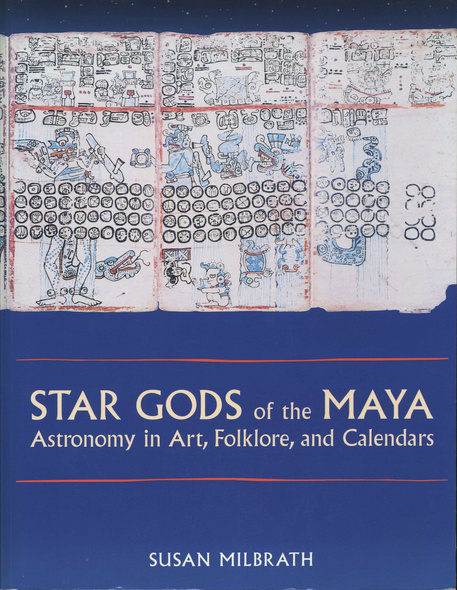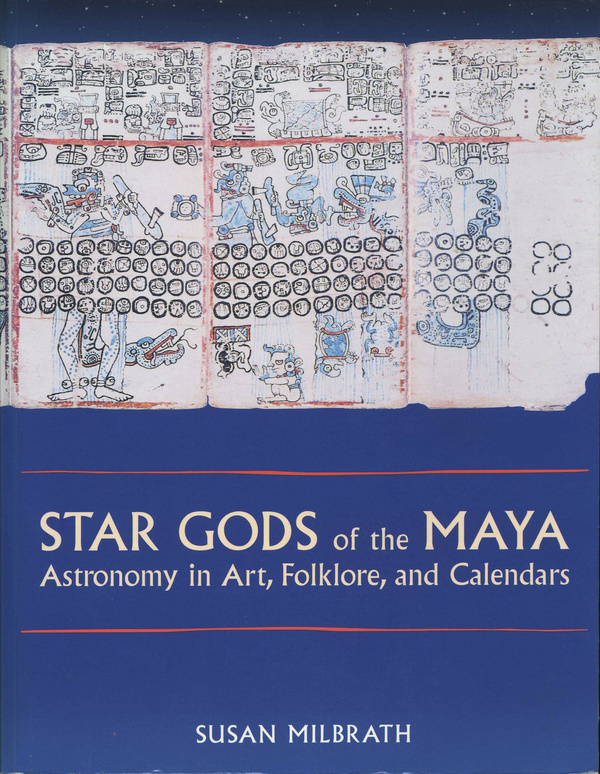
Star Gods of the Maya
Astronomy in Art, Folklore, and Calendars
Observations of the sun, moon, planets, and stars played a central role in ancient Maya lifeways, as they do today among contemporary Maya who maintain the traditional ways. This pathfinding book reconstructs ancient Maya astronomy and cosmology through the astronomical information encoded in Precolumbian Maya art and confirmed by the current practices of living Maya peoples.
Susan Milbrath opens the book with a discussion of modern Maya beliefs about astronomy, along with essential information on naked-eye observation. She devotes subsequent chapters to Precolumbian astronomical imagery, which she traces back through time, starting from the Colonial and Postclassic eras. She delves into many aspects of the Maya astronomical images, including the major astronomical gods and their associated glyphs, astronomical almanacs in the Maya codices [painted books], and changes in the imagery of the heavens over time. This investigation yields new data and a new synthesis of information about the specific astronomical events and cycles recorded in Maya art and architecture. Indeed, it constitutes the first major study of the relationship between art and astronomy in ancient Maya culture.
A prodigious work of unmatched interdisciplinary scholarship that will serve indefinitely as the basic reference for the study of Maya astronomy and religion.
Milbrath has given us a comprehensive reference work that facilitates access to a very broad and varied body of literature spanning several disciplines. It will serve for years to come as a gateway to the field for nonspecialists and a valuable research tool for all.
This book is destined to become a standard reference work on Maya archaeoastronomy.... [It provides] a basic, sound, and utterly comprehensive introduction to the subject of ancient Maya astronomy.
- Introduction
- The Mesoamerican Calendar
- Decipherment of Maya Glyphs
- Archaeoastronomy and Ethnoastronomy
- Overview of Contents
- 1. Contemporary Maya Images of the Heavens
- The Seasonal Cycle
- The Solar Calendar
- Modern Maya Cosmic Diagrams
- How the Sun Moves and Transforms
- The Sun God
- Images of Eclipses
- The Lunar Rhythms
- Lunar Agriculture
- The Celestial Pair
- The Moon Goddess
- Venus among the Contemporary Maya
- The Planets among the Contemporary Maya
- Stars and Constellations
- The Milky Way
- Other Celestial Phenomena
- Contemporary Maya Astronomy in Cultural Context
- 2. Naked-Eye Astronomy
- Tracking the Solar Seasons
- Lunar Positions and Phases
- Eclipses
- The Planets
- The Stars and the Seasons
- 3. Precolumbian and Colonial Period Maya Solar Images
- The Seasonal Cycle and the Solar Calendar
- Solar Orientations in Architecture
- The Sun in Precolumbian Maya Cosmic Diagrams
- Concepts of the Sun's Motion
- The Precolumbian Kin Glyph
- The Sun God in the Colonial and Postclassic Periods
- The Sun God at Chichén Itzá
- The Sun King
- Classic Maya Images of the Sun God and Earlier Prototypes
- The Monkey's Sun
- The Solar Bird and Solar Fire
- The Sun and Felines
- Hunahpu and Hun Ahau
- GIII: The Sun as the Middle Brother
- The Sun in the Precolumbian Maya Worldview
- 4. Precolumbian and Colonial Period Lunar Images and Deities
- Lunar Calendars
- Colonial and Postclassic Eclipse Imagery
- The Dresden Codex Eclipse Table
- Classic Period Eclipse Imagery and Events
- Maya Moon Glyphs and Symbols
- Lunar Symbolism of Fish, Frogs, Toads, and Shells
- The Moon and Rabbits
- The Water-lily Jaguar
- The Jaguar War God
- The Jaguar Paddler: The Moon Paired with the Sun
- The Lunar Twin: Xbalanque
- The Classic Period Moon God in Monumental Art
- The Young Moon Goddess in Colonial and Postclassic Times
- The Aged Moon in Colonial and Postclassic Times
- The Moon in the Postclassic Murals at Tulum
- Lunar Deities at Chichén Itzá
- The Classic Maya Moon Goddess
- The Ever-changing Moon
- 5. Venus and Mercury: The Body Doubles
- Venus Observations among the Precolumbian Maya
- Venus in the Popol Vuh
- Colonial and Postclassic Images of Venus
- The Dresden Codex Venus Pages
- The Layout of Pages 46-50
- The Seasonal Aspects of Venus
- Regents and Victims in the Venus Pages
- Quetzalcoatl-Kukulcan: The Venus God from Central Mexico
- Central Mexican Venus Symbols in the Maya Area
- Maya Glyphs and Symbols Representing Venus
- Venus Warfare
- Lineage Founders and the Venus Cult
- Tlaloc and the Storm God
- Chac and God B in Colonial and Postclassic Yucatán
- Classic Period Images of Chac
- Chac and GI in the Classic Period
- The Sidereal Position of Venus
- Venus and the Moon
- Mercury in Maya Imagery and Calendrics
- The Inferior Planets in the Maya Worldview
- 6. The Celestial Wanderers
- Colonial Period Images of the Superior Planets
- Mars among the Precolumbian Maya
- Monkey Deities and the Planets
- God K in the Colonial and Postclassic Periods
- The Classic Period God K and GII
- Jupiter Events and God K on Classic Maya Monuments
- Classic Period Calendar Records Relating to the Superior Planets
- Assembly of the Gods
- The Celestial Wanderers as Planetary Gods
- 7. Stars, the Milky Way, Comets, and Meteors
- Comets, Meteors, and Supernovas
- Images of Stars
- The Maya Zodiac
- The Pleiades
- The Scorpion and Skeletal Snake Constellations
- Orion and Gemini
- The Peccary Constellation
- Bird Constellations
- Cross Constellations and Stellar Trees
- The North Star and the "Dippers"
- Central Mexican Images of the Milky Way
- The Cosmic Monster and the Milky Way
- Serpent Forms of the Milky Way
- Four Roads in the Sky and Four Itzamnas
- Classic Period Monuments with Images of the Milky Way
- Rotating the Milky Way
- The Maya in the History of World Astronomy
- Appendix 1. Guide to Astronomical Identities
- Appendix 2. Table of Classic Period Dates and Associated Astronomical Events
- Appendix 3. Table for Calculating the Tzolkin Intervals
- Glossary
- Bibliography
- Index




